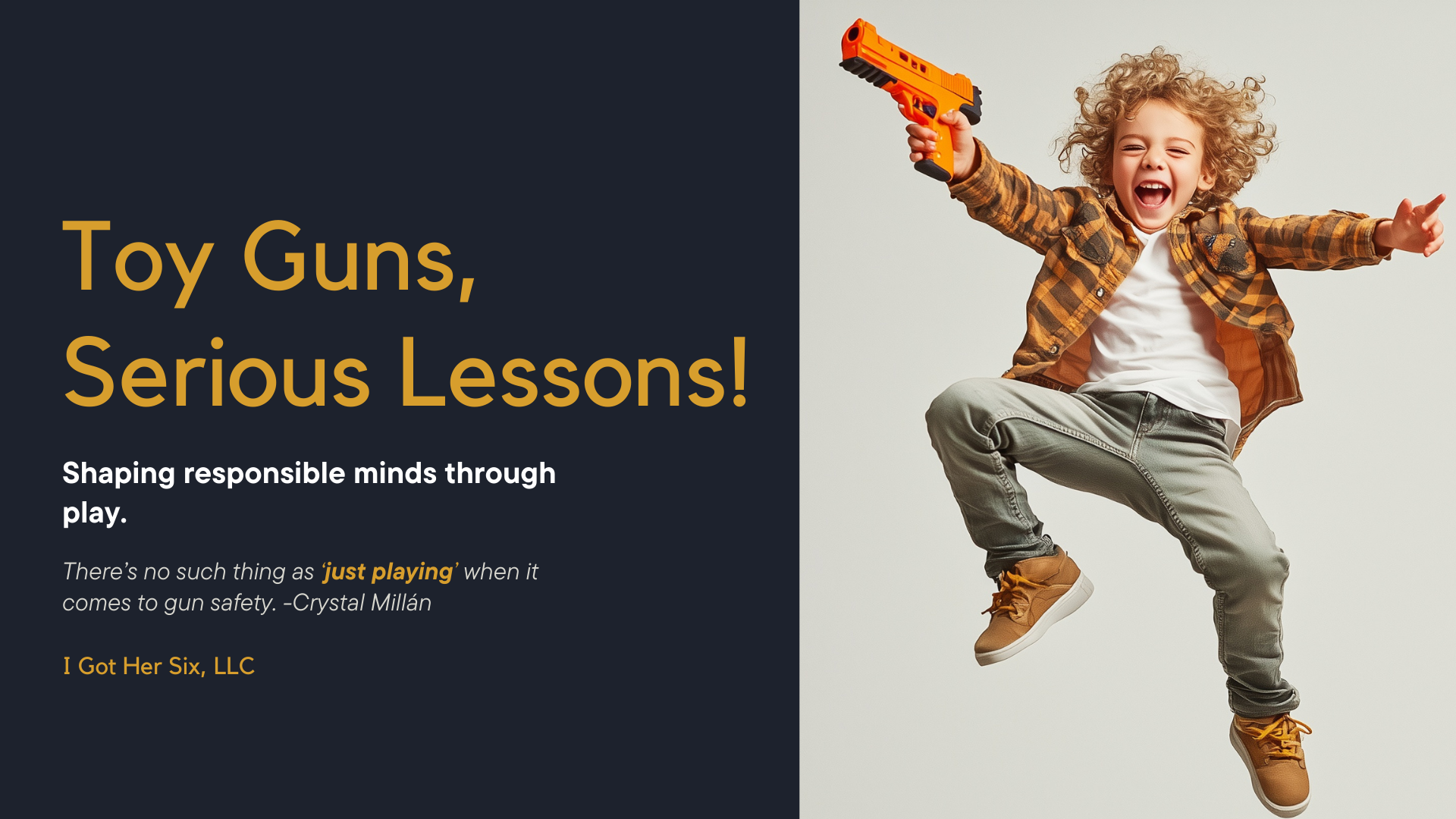I Got Her Six Blog
Your single place for all things safety when it come to firearms.
There’s No Such Thing as ‘Just Playing’ When It Comes to Gun Safety

There’s No Such Thing as ‘Just Playing’ When It Comes to Gun Safety
Parents, ask yourself: “What habits is my child building when they play with a toy gun?”
Why I Don’t Let My Children or Grandchildren Point Toy Guns at People
“Teach the habit before it becomes a mistake.” – Crystal Millán
In our family, playtime is full of imagination, creativity, and fun—but there’s one hard rule that never changes: never point a toy gun at another person. Some might say it’s just pretend, that kids are “just being kids,” but I take a different approach. One rooted in safety, responsibility, and real-life experience.
I teach my children and grandchildren to treat toy guns as if they are real firearms—not because I’m trying to take the fun out of their play, but because I understand how easily habits form at a young age, and how those habits can become life-saving—or life-threatening—muscle memory later in life.
Toy Guns May Be Fake—But Habits Are Real
From a developmental standpoint, children learn through imitation and repetition. Their brains are forming neural pathways that dictate how they behave without even thinking about it. That’s why we teach manners, hygiene, and seatbelt use early on—so it becomes second nature. Firearm safety should be no different.
When a child is allowed to run around pointing toy guns at people, they’re creating a normal behavior loop. Their brain learns, “It’s okay to aim this at someone,” and that idea can carry over—especially when they later encounter a real firearm in a home, at a friend’s house, or even accidentally.
The Danger of Normalizing Unsafe Behavior
Consider this scenario: a child raised to treat toy guns casually stumbles upon a loaded firearm in a nightstand drawer. They’ve been “shooting” at people with toys their entire life. What’s to make them pause and think that this time is different? There may be no pause at all. That’s how tragic accidents happen—and they do, far too often.
According to the CDC, unintentional firearm injuries among children remain a serious concern, and many of these incidents happen in the home, often involving another child. These are not “bad kids” or negligent parents. These are simply families who may not have made firearm safety part of their daily teaching—until it was too late.
Muscle Memory Saves Lives
In the firearm safety world, we talk a lot about “muscle memory.” It's what allows responsible gun owners to react safely and correctly under stress without needing to stop and think. That muscle memory starts with consistent habits.
When we teach kids never to point even a fake gun at a person, we’re programming them to respect the seriousness of firearms from day one. We’re teaching them to:
- Always treat every firearm as if it is loaded.
- Never point it at something they don’t intend to destroy.
- Keep their finger off the trigger until they’re ready to shoot.
- Be aware of their target and what’s beyond it.
These are the four basic rules of gun safety—and yes, we teach them using Nerf guns and water pistols. We make it a part of play, not to instill fear, but to build awareness.
"But They're Just Kids..."
Yes—they’re just kids. And that’s exactly why we have to teach them now. When they’re young is when they’re most impressionable, most eager to please, and most open to learning. Children thrive with boundaries, and when we explain why we do what we do, they internalize those values for life.
This doesn’t mean play has to be stiff or serious. They can still play cops and robbers, water fights, and shoot cans with foam darts. We just teach them to do it the right way—never aiming at people, always aiming at objects, and treating their toy “firearms” like tools that demand respect.
Building a Culture of Safety at Home
Firearm safety doesn’t begin when a child turns 18. It begins when they pick up their first toy gun. The world is full of real dangers, and it’s our job as parents and grandparents to prepare them—not shield them, but empower them with knowledge and habits that protect.
Every family has their own values, and this is one of ours. We believe that every life is worth protecting, especially the lives of those we love most. So when we don’t allow our kids to point toy guns at others, it’s not just a rule. It’s a lesson in respect, responsibility, and real-life readiness.
If you’re a parent or grandparent reading this, consider the habits being built in your home. You don’t have to own a real firearm to teach firearm safety. And you don’t have to be a safety instructor to make a difference.
You just have to care enough to say:
“Not in this house. Not today. Not ever.”

